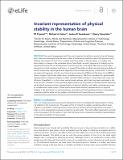| dc.contributor.author | Pramod, RT | |
| dc.contributor.author | Cohen, Michael A | |
| dc.contributor.author | Tenenbaum, Joshua B | |
| dc.contributor.author | Kanwisher, Nancy | |
| dc.date.accessioned | 2023-03-28T17:26:03Z | |
| dc.date.available | 2023-03-28T17:26:03Z | |
| dc.date.issued | 2022 | |
| dc.identifier.uri | https://hdl.handle.net/1721.1/148827 | |
| dc.description.abstract | <jats:p>Successful engagement with the world requires the ability to predict what will happen next. Here, we investigate how the brain makes a fundamental prediction about the physical world: whether the situation in front of us is stable, and hence likely to stay the same, or unstable, and hence likely to change in the immediate future. Specifically, we ask if judgments of stability can be supported by the kinds of representations that have proven to be highly effective at visual object recognition in both machines and brains, or instead if the ability to determine the physical stability of natural scenes may require generative algorithms that simulate the physics of the world. To find out, we measured responses in both convolutional neural networks (CNNs) and the brain (using fMRI) to natural images of physically stable versus unstable scenarios. We find no evidence for generalizable representations of physical stability in either standard CNNs trained on visual object and scene classification (ImageNet), or in the human ventral visual pathway, which has long been implicated in the same process. However, in frontoparietal regions previously implicated in intuitive physical reasoning we find both scenario-invariant representations of physical stability, and higher univariate responses to unstable than stable scenes. These results demonstrate abstract representations of physical stability in the dorsal but not ventral pathway, consistent with the hypothesis that the computations underlying stability entail not just pattern classification but forward physical simulation.</jats:p> | en_US |
| dc.language.iso | en | |
| dc.publisher | eLife Sciences Publications, Ltd | en_US |
| dc.relation.isversionof | 10.7554/ELIFE.71736 | en_US |
| dc.rights | Creative Commons Attribution 4.0 International license | en_US |
| dc.rights.uri | https://creativecommons.org/licenses/by/4.0/ | en_US |
| dc.source | eLife | en_US |
| dc.title | Invariant representation of physical stability in the human brain | en_US |
| dc.type | Article | en_US |
| dc.identifier.citation | Pramod, RT, Cohen, Michael A, Tenenbaum, Joshua B and Kanwisher, Nancy. 2022. "Invariant representation of physical stability in the human brain." eLife, 11. | |
| dc.contributor.department | Massachusetts Institute of Technology. Department of Brain and Cognitive Sciences | en_US |
| dc.relation.journal | eLife | en_US |
| dc.eprint.version | Final published version | en_US |
| dc.type.uri | http://purl.org/eprint/type/JournalArticle | en_US |
| eprint.status | http://purl.org/eprint/status/PeerReviewed | en_US |
| dc.date.updated | 2023-03-28T17:06:09Z | |
| dspace.orderedauthors | Pramod, RT; Cohen, MA; Tenenbaum, JB; Kanwisher, N | en_US |
| dspace.date.submission | 2023-03-28T17:06:12Z | |
| mit.journal.volume | 11 | en_US |
| mit.license | PUBLISHER_POLICY | |
| mit.metadata.status | Authority Work and Publication Information Needed | en_US |
